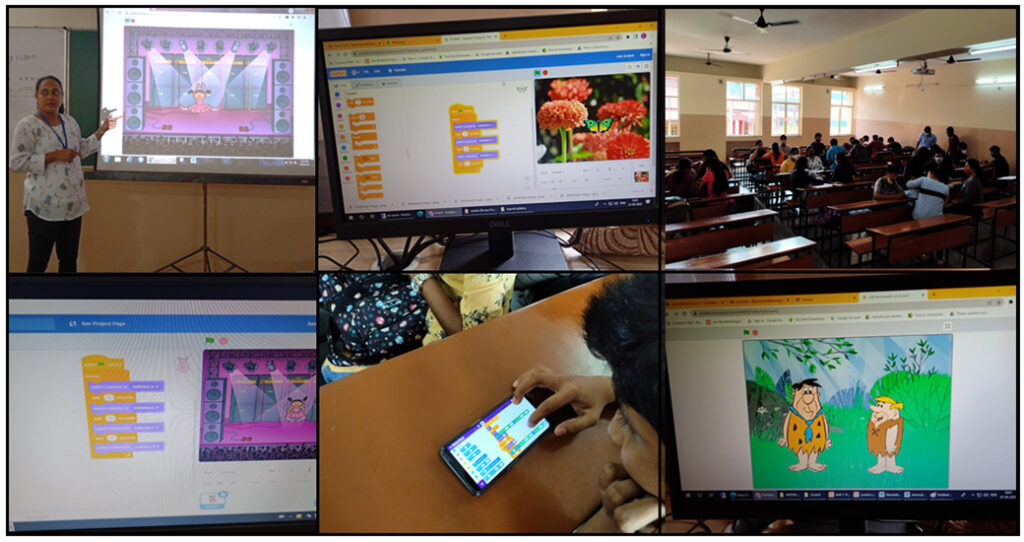BEYOND SYLLABUS ACTIVITY FOR FE ETC

The Department of Electronics and Telecommunication Engineering, DBCE decided to allocate 2 hours every week for beyond syllabus activities for the first Year ETC students. To conduct this activity Dr. D.S Vidhya and Prof. Flavia Leitao were identified as the two resource persons from the ETC Department, who would arrange for some activity which would help students to learn something beyond the syllabus.
In view of the above objective some of the activities planned by them were hands-on manual PCB Design workshop, Circuit Simulation using SimulIDE, Animation, Video making and so on.
PCB Design workshop: The session started with Prof. Flavia Leitao briefing the students on the different stages of PCB Design. The stages involved Testing the circuit on breadboard, Drawing circuit layout and transferring mirror image of layout on PCB, Masking, Etching to remove the unwanted copper, Drilling and mounting of components and finally Soldering.
The students were given a hands-on experience in designing the PCB. They first started with testing the circuit on breadboard, to verify if the circuit given to them was working, which was followed by the masking activity, where they had to transfer the mirror image of the layout on the PCB. A very innovative and easy method of doing this was employed using the Iron. The mask was smoothened by the markers to avoid any break in the copper tracks. The masking was followed by Etching, where Ferric Chloride was used for removing the unwanted copper. The PCB was then nicely cleaned to remove the entire mask.

The etching activity was followed by drilling and Soldering. The students were first given instructions and a demo on how to use the drilling machine and the soldering iron. The students then got a hands-on exposure to drilling and soldering.
The circuit implemented on the PCB was an “Astable Multivibrator”. The students showed great zeal and enthusiasm in designing the PCB and the satisfaction and joy to see the circuit work was overwhelming.
Circuit Simulation using SimulIDE: Keeping in mind that these were electronic students, the instructors taught them a Simulation software called SimulIDE. SimulIDE is a simple real time electronic circuit simulator, intended for hobbyist or students to learn and experiment with simple electronic circuits and microcontrollers, supporting PIC, AVR, Arduino. Simplicity and ease of use are the key features of this simulator.
One can create, simulate and interact with the circuits within minutes, just drag components from the list, drop into the circuit, connect them and push power button to see how it works.
Students were told to simulate all their Electrical and Electronic lab experiments, so that they could get a better understanding of those concepts.

Animation using Scratch: The next interesting activity that was conducted was to educate students on making Animations. The software used for this was Scratch which is a simple visual interface that allows young people to create digital stories, games, and animations.
The students can use Scratch to code their own interactive stories, animations, and games. In the process, they learn to think creatively, reason systematically, and work collaboratively, which are the essential skills for everyone in today’s society.
Scratch is also available as a mobile app called PictoBlox. It is a block-based coding and an AI education platform. Students had great fun creating their own games, animations, make characters mimic their actions and enact stories by setting up a stage for them.
Video Making: The next activity that was planned for students was the video making activity which is something everybody must know today. To make it more fun and challenging students were asked to explore the different video making softwares and select those softwares as per their preference. The topic given for Video making was “The Rich Heritage of Goa”. The students did a brilliant job and came up with great ideas showcasing Goa’s culture and heritage through Video Making.

Introduction and demonstration of Electrical components:
A session on “Introduction and Demonstration of Electrical components” was yet another session organised for the students under beyond syllabus activity. Mr. Jayprakash Fadte introduced to the students various electrical components available in the laboratory. He also explained about Earthing, various types of DC, AC motors and power supplies. The types of domestic and industrial wiring also were mentioned to the students. This was accompanied by demonstration of soldering. The students showed great curiosity to learn.












 Visit Today : 642
Visit Today : 642